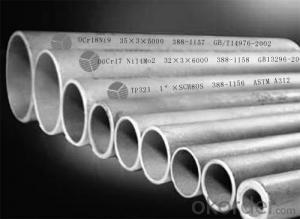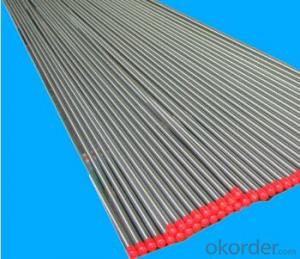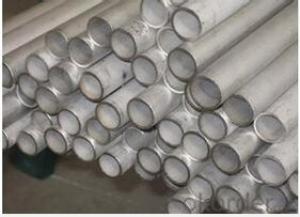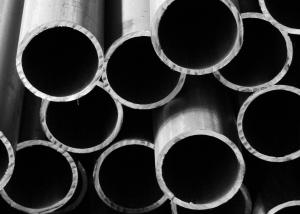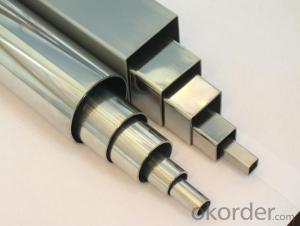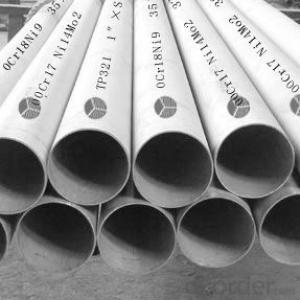Stainless Duplex Seamless Steel Pipe 31500
- Loading Port:
- Ningbo
- Payment Terms:
- TT OR LC
- Min Order Qty:
- 1 m.t.
- Supply Capability:
- 5000 m.t./month
OKorder Service Pledge
OKorder Financial Service
You Might Also Like
1、Structure of Stainless Duplex Seamless Steel Pipe 31500 Description:
Duplex Stainless steel pipe and tubing are used for a variety of reasons: to resist corrosion and oxidation, to resist high temperatures, for cleanliness and low maintenance costs, and to maintain the purity of materials which come In contact with stainless. The inherent characteristics of stainless steel permit the design of thin wall piping systems without fear of early failure due to corrosion.2、Main Features of the Duplex Seamless Steel Pipe 31500:
• High manufacturing accuracy
• High strength
• Small inertia resistance
• Strong heat dissipation ability
• Good visual effect
•Reasonable price
3、Duplex Seamless Steel Pipe 31500 Images:
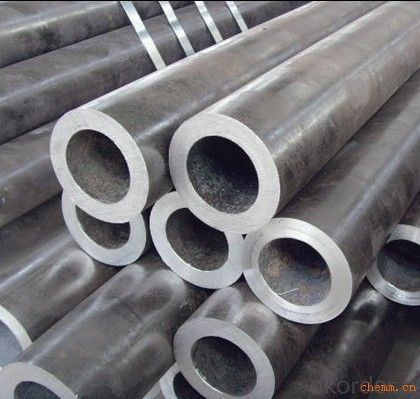
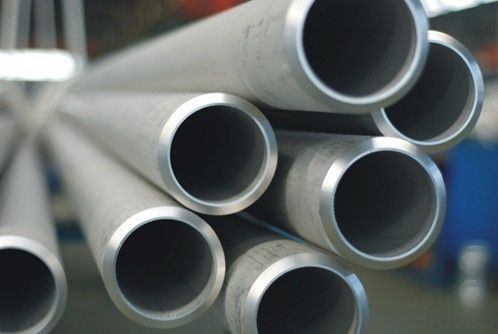
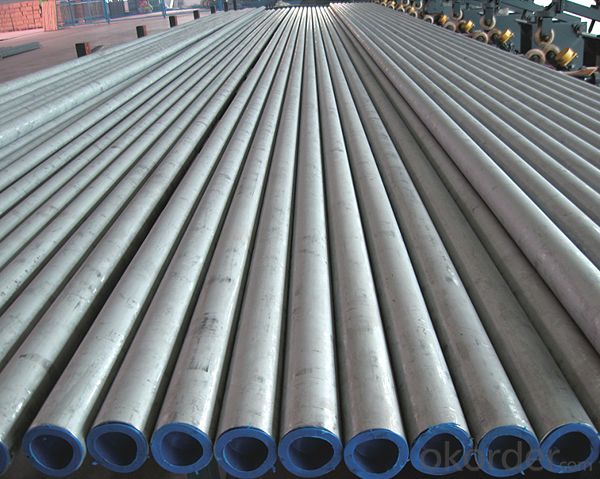
4、Duplex Seamless Steel Pipe 31500 Specification:
Detail infomation
Standards: ASTM/ASME A789/SA789, A790/SA790,A450,A530
Material: UNS S31803(Cr22Ni5Mo3/1.4462)/2205,UNS S32750(1.4410),UNS S31500(Cr18NiMo3Si2),
UNS32760(1.4501)
Chemical Composition
Grade | C max | Si max | Mn max | P max | S max | Cr | Ni | Mo | N |
UNS S32750 | 0.030 | 0.8 | 1.2 | 0.030 | 0.015 | 24.0-26.0 | 6.0-8.0 | 3.0-5.0 | 0.24-0.32 |
UNS S31803 | 0.030 | 1.0 | 2.0 | 0.020 | 0.020 | 21.0-23.0 | 4.5-6.5 | 2.5-3.5 | 0.08-0.20 |
UNS S31500 | 0.030 | 1.0 | 1.2-2.0 | 0.030 | 0.030 | 18.0-19.0 | 4.5-5.5 | 2.5-3.5 | 0.05-0.10 |
Physical Properties
Grade | Y.S.MPa min | T.S.Mpa min | Elongation % | Hardness HRC |
UNS S32750 | 550 | 800 | 15 | 20 |
UNS S31803 | 450 | 620 | 25 | 20 |
UNS S31500 | 440 | 630 | 30 | 20 |
Supplementary Testing :
we also carry out on the manufactured products supplementary testing.
Radiography Testing |
Macro Testing |
Liquid Penetrate testing |
5、FAQ of Duplex Seamless Steel Pipe 31500:
①How is the quality of your products?
Our products are manufactured strictly according to national and internaional standard, and we take a test
on every pipe before delivered out. If you want see our quality certifications and all kinds of testing report, please just ask us for it.
Guaranteed: If products’ quality don’t accord to discription as we give or the promise before you place order, we promise 100% refund.
②How about price?
Yes, we are factory and be able to give you lowest price below market one, and we have a policy that “ for saving time and absolutely honest business attitude, we quote as lowest as possible for any customer, and discount can be given according to quantity”,if you like bargain and factory price is not low enough as you think, just don’t waste your time.Please trust the quotation we would give you, it is professional one.
③Why should you chose us?
Chose happens because of quality, then price, We can give you both.Additionally, we can also offer professional products inquiry, products knowledge train(for agents), smooth goods delivery, exellent customer solution proposals.Our service formula: good quality+good price+good service=customer’s trust
SGS test is available, customer inspection before shipping is welcome, third party inspection is no problem.
Any question, pls feel free to contact us !
- Q: Can stainless steel pipes be used for pharmaceutical processing equipment?
- Yes, stainless steel pipes can be used for pharmaceutical processing equipment. Stainless steel is a preferred material in the pharmaceutical industry due to its excellent corrosion resistance, durability, and ease of cleaning. It is resistant to chemicals, corrosion, and high temperatures, making it suitable for handling and transporting various pharmaceutical substances. Additionally, stainless steel pipes have a smooth surface that minimizes the risk of contamination and allows for easy cleaning and sterilization. Overall, stainless steel pipes are widely used in pharmaceutical processing equipment to ensure the integrity and quality of pharmaceutical products.
- Q: Can stainless steel pipes be used for hygienic applications?
- Indeed, hygienic applications can utilize stainless steel pipes. In industries such as food and beverage, pharmaceuticals, and biotechnology, where cleanliness is paramount, stainless steel is a highly durable and corrosion-resistant material commonly employed. The smooth surface of stainless steel pipes hinders the growth of bacteria and other microorganisms, making them an appropriate choice for applications that require cleanliness. Furthermore, their smooth surface facilitates easy and thorough cleaning, thereby minimizing the risk of contamination. Furthermore, stainless steel pipes do not react with substances and do not release any harmful materials into the products being transported. This characteristic makes them particularly suitable for applications that demand sanitary conditions, such as in the production and transportation of food, beverages, and pharmaceuticals. Additionally, stainless steel pipes exhibit exceptional resistance to high temperatures, chemicals, and corrosion, thereby guaranteeing the integrity of the system and preventing any contamination or leaks. They are also highly durable and can withstand harsh operating conditions, making them a dependable option for hygienic applications. To summarize, stainless steel pipes possess the necessary attributes, including durability, corrosion resistance, smooth surface, ease of cleaning, and non-reactivity, to cater to hygienic applications. They offer a reliable and sanitary solution for industries that prioritize hygiene.
- Q: Can stainless steel pipes be wrapped with fiberglass insulation?
- Yes, stainless steel pipes can be wrapped with fiberglass insulation.
- Q: What are the different types of stainless steel pipe insulation?
- There are several types of stainless steel pipe insulation available, including fiberglass, mineral wool, foam, and elastomeric foam. These materials provide different levels of thermal performance, durability, and resistance to moisture and chemicals, allowing users to choose the most suitable option for their specific needs.
- Q: What is the difference between Sch 40 and Sch 80 stainless steel pipes?
- The main difference between Sch 40 and Sch 80 stainless steel pipes lies in their thickness. Sch 40 pipes have a thinner wall thickness compared to Sch 80 pipes, which means they have a lower pressure rating. On the other hand, Sch 80 pipes have a thicker wall thickness, making them suitable for higher pressure applications.
- Q: Can stainless steel pipes be insulated with polybutylene?
- No, stainless steel pipes cannot be insulated with polybutylene. Polybutylene is a type of plastic material that is commonly used as a water supply pipe. It is not suitable for insulating stainless steel pipes. Stainless steel pipes are already highly resistant to corrosion and do not require additional insulation for thermal purposes. If insulation is needed for stainless steel pipes, other materials such as fiberglass or foam pipe insulation can be used.
- Q: Are stainless steel pipes suitable for pharmaceutical clean rooms?
- Yes, stainless steel pipes are highly suitable for pharmaceutical clean rooms. They are preferred due to their excellent resistance to corrosion, durability, and ease of cleaning. Stainless steel pipes provide a hygienic and contaminant-free environment, making them ideal for pharmaceutical clean rooms where maintaining cleanliness and sterility is crucial.
- Q: Can stainless steel pipes withstand high temperatures?
- Yes, stainless steel pipes are known for their excellent heat resistance and can withstand high temperatures. The specific temperature range that stainless steel pipes can withstand depends on the grade of stainless steel used. Generally, stainless steel pipes can handle temperatures up to 1200°C (2192°F) without losing their structural integrity. In addition to their high-temperature resistance, stainless steel pipes also exhibit good corrosion resistance, making them suitable for various industrial applications where high temperatures and corrosive environments are present, such as in chemical processing plants, power generation facilities, and automotive exhaust systems.
- Q: Are stainless steel pipes suitable for underground installations?
- Yes, stainless steel pipes are suitable for underground installations. Stainless steel is highly resistant to corrosion and is known for its durability and strength. It can withstand harsh underground conditions, including moisture, soil movement, and chemical exposure. Stainless steel pipes are also immune to rust and do not require protective coatings, making them ideal for long-term underground use. Additionally, stainless steel pipes have a long lifespan and require minimal maintenance, further enhancing their suitability for underground installations.
- Q: How do you calculate the wall thickness of a stainless steel pipe?
- The wall thickness of a stainless steel pipe can be calculated by subtracting the inner diameter from the outer diameter, and then dividing the result by 2.
Send your message to us
Stainless Duplex Seamless Steel Pipe 31500
- Loading Port:
- Ningbo
- Payment Terms:
- TT OR LC
- Min Order Qty:
- 1 m.t.
- Supply Capability:
- 5000 m.t./month
OKorder Service Pledge
OKorder Financial Service
Similar products
Hot products
Hot Searches
Related keywords
